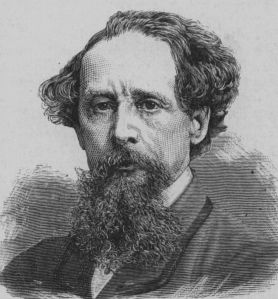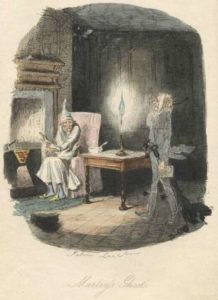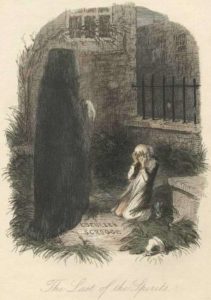With the recent release of the blockbuster The Man Who Invented Christmas, the world has A Christmas Carol, Charles Dickens’ masterpiece of a book, on its mind. The movie tells the true tale of a journey that led Dickens’ to pen A Christmas Carol, or A Christmas Carol (in Prose): a Ghost Story of Christmas. The film’s popularity is a mere shadow of the popularity of the book itself.
The Popularity of Charles Dickens’ A Christmas Carol
Charles Dickens (1812-1870) began his work on A Christmas Carol in October of 1843. On December 17th of the same year, the book was available for purchase in stores. Six thousand copies were sold in the first six days that it was available.
The book’s popularity grew into the New Year and beyond. Also…
- Within eight weeks of the book’s release, eight stage adaptations of it were made.
- Public readings of the story were given by Charles Dickens himself, which were immensely popular.
- Dickens was 31 years old at the time A Christmas Carol was written.
Why Did Dickens Write A Christmas Carol?
A Christmas Carol, which its author referred to as “a Ghostly little book,” was written in the midst of The Ragged School Movement. The movement was established around 1818 by English shoemaker John Pounds. He started the movement by providing free education to poor children. 350 Ragged Schools had been established by 1870.
“As well as giving very elementary education, the Ragged Schools engaged in a wide variety of social welfare activities such as running Penny Banks, Clothing Clubs, Bands of Hope, and Soup Kitchens. However, despite their alternate name of Industrial Feeder Schools, only three Ragged Schools gave trade instruction, the only form of education for which Government grants were available(1).”
The Ragged School Movement appealed to Charles Dickens, an avid humanitarian. His concern for the welfare of the poor, specifically for children, and disgust with the stingy upper-class probably helped inspire him to write A Christmas Carol.
“Dickens was involved in charities and social issues throughout his entire life. At the time that he wrote A Christmas Carol he was very concerned with impoverished children who turned to crime and delinquency in order to survive (2).”
There’s no doubt that Charles Dickens was passionate about helping the poor. This passion beautifully colored his writing.
Did Charles Dickens’ Impoverished Childhood Inspire A Christmas Carol?
The most probable reason Dickens had such a soft spot for poor, working-class children is because he had firsthand knowledge of their plight. Due to his family’s financial struggles, he was forced to begin working at age twelve at a shoe polish company (3). When his father was thrown into prison because of debt, young Charles’ family moved closer to the prison, leaving him to live alone. This lonely, traumatic experience no doubt affected his overall perception of himself and the world. It likely inspired him to write A Christmas Carol as a grown man.
John Leech, Though Supportive of Anti-Americanism and Anti-Semitism, Illustrated A Christmas Carol
Although he had only a few weeks to collect them, the illustrations of A Christmas Carol were no doubt important to Charles Dickens. He chose English caricaturist and illustrator John Leech, who was 26 at the time, to illustrate the book.
Leech was an influential man, though he didn’t always use his influence for good. He was best known for his contributions to Punch, “a humorous magazine for a broad middle-class audience, combining verbal and graphic political satire with light social comedy. Leech catered to contemporary prejudices, such as anti-Americanism and anti-Semitism and supported acceptable social reforms. Leech’s critical yet humorous cartoons on the Crimean War help shape public attitudes toward heroism, warfare, and Britain’s role in the world (4).”
Descriptions of A Christmas Carol’s Four Illustrations
John Leech provided four hand-colored steel engravings for A Christmas Carol. He illustrated four additional plates for Dickens’ other Christmas novels in later years. Lehigh University described three of the plates John Leech illustrated for A Christmas Carol (5):
1. “Marley’s Ghost” depicts Scrooge being visited by the deceased Jacob Marley, who was his business partner for many years in reality. Jacob is explaining to Scrooge that he will be visited by three Ghosts in the coming days. This is to save Scrooge from damnation.
2. “Mr. Fezziwig’s Ball” depicts Mr. and Mrs. Fezziwig dancing at the annual employee-appreciation Christmas ball. The Ghost of Christmas Past reveals this memory to Scrooge in order to remind him of “his duty to his own employee, Bob Cratchit.”
3. “Scrooge’s Third Visitor” depicts Father Christmas, who is the Ghost of Christmas Present. Leech’s illustration brought to life this character who, created by Dickens, has influenced the way people relate to the Christmas holiday.
The Victorian Web provided a description of the final plate (6):
4. “The Last of the Spirits” is the most frightening of all the illustrations. It depicts the Ghost of Christmas Future pointing the grave that Scrooge is destined for. This is a pivotal point in the story as it frightens Scrooge into becoming a changed, good-hearted man.
It is ironic that a man who was supportive of anti-American, anti-Semitic attitudes was given the privilege of illustrating a timeless tale of inclusion, understanding, and goodwill toward humanity. This is a demonstration of the graceful message A Christmas Carol announces, which is that everyone is capable of doing good, no matter his or her prejudices. Whether he meant to or not, John Leech did the world great service by beautifully bringing A Christmas Carol to life in our imaginations. In this case, Leech’s influenced was used for incredible good. This redemption of Leech’s influence adds to the warmth of A Christmas Carol.
“I Will Honor Christmas in My Heart, and Try to Keep It All the Year.”
“I will honor Christmas in my heart, and try to keep it all the year. I will live in the Past, the Present, and the Future. The Spirits of all Three shall strive within me. I will not shut out the lessons that they teach!”
These words were exclaimed by Scrooge near the end of A Christmas Carol. They are a reminder to all of us, whether we celebrate Christmas or not, to choose to have loving, charitable, and kind attitudes and actions toward all mankind. If a character like Scrooge could make these resolutions, surely there is hope for each of us.
If you’ve never read A Christmas Carol and would like to, do so here.
Read more Segmation blog posts about Christmas, art, and redemption:
- Jessie Willcox Smith’s “Twas The Night Before Christmas” Illustrations
- Celebrating Over 100 Years of Christmas Lights
- Norman Rockwell’s Artwork Inspired by the Christmas Holiday
Be an Artist in 2 minutes with Segmation SegPlay® PC (see more details here)
SegPlay® Mobile available for Amazon Fire, iPhone, iPad, Android
References
- Maybole.org. The history of ragged schools. http://www.maybole.org/history/articles/historyofraggedschools.htm.
- Charles Dickens Info. Learn about A Christmas Carol. https://www.charlesdickensinfo.com/christmas-carol/.
- Encyclopedia of World Biography. Charles Dickens biography. http://www.notablebiographies.com/De-Du/Dickens-Charles.html.
- Wikipedia. John Leech (caricaturist). https://en.wikipedia.org/wiki/John_Leech_(caricaturist).
- Lehigh University. John Leech. https://omeka.lehigh.edu/exhibits/show/dickens/illus/leech.
- The Victorian Web. The last of the spirits. http://www.victorianweb.org/art/illustration/carol/7.html.










